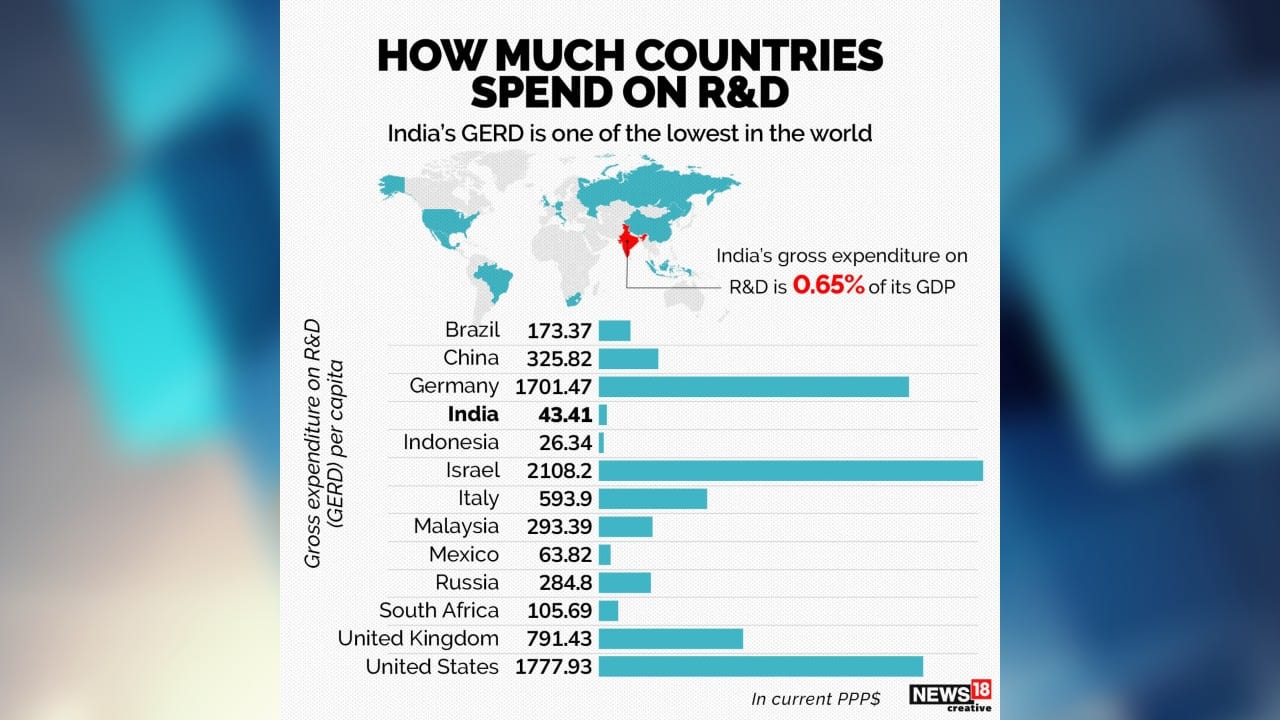India’s R&D funding, breaking down the numbers
Source: TH Table of Contents ToggleRelevance: GS 2: Government policies, Education Prelims: Science and Engineering Research Board, Atal Innovation Mission, Digital India R&D Fund Mains: Q. Scientific research in Indian universities is declining, because a career in science is not as attractive as our business operations, engineering or administration, and the universities are becoming consumer oriented. Critically comment. (2014) Q. Why is Public Private Partnership (PPP) required in infrastructural projects? Examine the role of PPP model in the redevelopment of Railway Stations in India. (2022) |
Introduction
- The announcement of a ₹1 lakh crore corpus in the interim Budget for 2024-25 to bolster research and innovation has sparked enthusiasm.
- Rebranding the slogan to ‘Jai Jawan, Jai Kisan, Jai Vigyan, Jai Anusandhan’ aims to reinforce research and innovation for development.

Research Output and Innovation
- Despite low R&D expenditure as a percentage of GDP (0.64%), India excels in producing academic talent, with 40,813 PhDs annually, ranking third globally.
- India ranks third globally in research output, with over 3,00,000 publications in 2022, and sixth in patent grants with 30,490 patents granted in 2022.

Investment in R&D
- Gross Expenditure on Research and Development (GERD) increased from ₹6,01,968 million in 2010-11 to ₹12,73,810 million in 2020-21.
- Government sector primarily drives GERD (54%), with significant contributions from Defence Research and Development Organisation, Department of Space, etc.
- Private sector contributes only 36.4% to GERD ($6.2 billion), lagging behind global trends where businesses typically contribute over 65%.
Role of Higher Education Institutions (HEIs)
- HEIs contribute 8.8% ($1.5 billion) to R&D investment, indicating a comparatively minor role.
- Stronger industry-academia collaboration is essential for knowledge transfer and fostering innovation.
Impact of Initiatives
- Initiatives like the National Deep Tech Startup Policy (NDTSP) aim to incentivize private sector engagement in R&D.
- The enactment of the Anusandhan National Research Foundation (ANRF) Act aims to bridge India’s R&D investment gap and nurture a robust research culture.
- Challenges include ensuring equitable fund distribution, fostering interdisciplinary collaborations, and upholding global standards.
Conclusion
- India’s R&D aspirations require encouraging private sector involvement and fortifying academia’s research infrastructure.
- The interim Budget, NDTSP, and ANRF Act signal India’s commitment to incentivizing private sector-led research and innovation, particularly in burgeoning industries.
A fresh stance: On India and the European Free Trade Association deal
Source: IE Relevance: GS 2: International Relations Prelims: WTO (World Trade Organization), Free Trade Agreement (FTA), Carbon Border Adjustment Mechanism (CBAM) Mains: What obstacles hinder the India-EU Free Trade Agreement, and how can they be addressed? |
Introduction:
- India recently signed a Trade and Economic Partnership Agreement (TEPA) with the European Free Trade Association (EFTA), consisting of Iceland, Liechtenstein, Norway, and Switzerland.
- Negotiations commenced in 2008 but gained traction post the UPA government’s departure, with the primary objective of enhancing trade, investment, and employment opportunities.

About the European Free Trade Association (EFTA) Bloc:
- Member Countries: Iceland, Liechtenstein, Norway, Switzerland
- Formation: Founded in 1960 by seven European nations as an alternative trade bloc to the EU.
- Activities: Participate in the European Single Market through the EEA Agreement.
- Institutions: Governed by institutions like the EFTA Court, EFTA Surveillance Authority, and EFTA Secretariat.
Trade and Economic Partnership Agreement (TEPA):
Overview:
- The India-EFTA TEPA entails a commitment from the European bloc to invest $100 billion in India over a span of 15 years, focusing on sectors like pharmaceuticals, food processing, engineering, and chemicals.
- Notably, this investment commitment, a pioneering move within an FTA, is expected to primarily stem from provident funds in EFTA countries, including Norway’s $1.6-trillion sovereign wealth fund, renowned as the world’s largest pension fund.
- However, it’s crucial to note that while significant, this investment commitment may not hold legal binding and falls under the category of “investment promotion.” Additionally, it differs from a Bilateral Investment Treaty (BIT) as being negotiated with the UK and the EU.
Benefits of TEPA:
For EFTA:
- Historically, trade agreements with India have benefited partner countries due to India’s relatively high average tariffs, standing at around 18%, among the highest globally.
- Following the India-EFTA deal, there could be a notable increase in imports of machinery, pharmaceuticals, medical instruments, and machinery into India due to a sharp reduction in Indian tariffs. Consequently, the investment commitment plays a crucial role, especially considering that India-EFTA trade significantly favors the European grouping in terms of goods.
- For instance, India currently maintains a substantial trade deficit with Switzerland, which could potentially widen post the elimination of duties as part of the deal.
For India:
- India aims to attract investments and secure better market access for its service sector workforce through the TEPA.
- EFTA expresses interest in establishing joint ventures particularly in sectors like pharmaceuticals (especially medical devices), chemicals, food processing, and engineering.
- Furthermore, India views the EFTA deal as an opportunity to diversify its imports away from China, particularly in light of its current dependency on China for critical medical imports.
Significance
- Tariff Reduction and Market Access: Tariff Reduction and Simplified Customs Procedures: The India-EFTA trade deal ensures a reduction in tariffs, facilitates increased market access, and simplifies customs procedures.
- Sustainable Development Commitments: Inclusion of Human Rights and Sustainable Development: Notably, the FTA includes, for the first time, a dedicated chapter outlining commitments to human rights and sustainable development.
- Template for Dealing with Developed Nations: Potential Template for Dealing with Developed Nations: The pact sets a precedent that could serve as a template for negotiating with developed nations. Such nations, with greater market access in a high-tariff country like India, can offer investments. This template facilitates smoother negotiations and trade agreements.
- Additional Note: The Trade and Economic Partnership Agreement (TEPA) represents the second comprehensive FTA signed by India, following the agreement with the United Arab Emirates.
Various Roadblocks to India-EU Free Trade Agreement:
- Absence of Common Working Visa System: The EU lacks a unified working visa system, impeding the free movement of Indian professionals across EU nations. This absence serves as a significant barrier, prompting India to seek a lasting solution to the issue.
- Rising Non-Tariff Barriers: Indian companies encounter growing challenges in accessing European markets due to escalating non-tariff barriers. These barriers manifest in various forms such as technical regulations, phytosanitary measures, industrial standards, conformity assessments, and barriers to services exports.
- EU’s Demands for Strengthened Intellectual Property Regime: A hurdle to an agreement lies in the EU’s insistence on a robust intellectual property regime in India, alongside the inclusion of a sustainable development chapter encompassing stringent labor and environmental protections.
- Proposal for Investor-State Dispute Settlement Mechanism: Friction arises from the EU’s proposal to establish an investor-state dispute settlement mechanism, conflicting with existing Indian laws. This mechanism would enable EU investors to challenge the Indian government before an international tribunal.
- Liberalization of Accountancy and Legal Services: Another sticking point is the EU’s desire for India to liberalize accountancy and legal services. However, this proposition sparks controversy as India currently does not permit foreign lawyers and accountants to practice within its borders.
Way Forward:
- Engagement in Rigorous Diplomatic Dialogue: India must engage in robust diplomatic efforts to address outstanding issues through dialogue. Efforts should focus on conveying concerns related to market access and visa restrictions to the EU.
- Emphasis on Lobbying in the EU: It’s crucial to prioritize lobbying efforts within the EU to influence its lawmakers. Diplomatic endeavors through the Indian diaspora and business lobby are imperative in this regard.
- Leveraging Brexit for Stronger Trade Relations: Brexit presents a fresh opportunity for India to bolster its economic ties with the EU through the negotiation of an India-EU free trade agreement (FTA).
- Further Liberalization of FDI Regime: India has notably relaxed its FDI policies, resulting in increased FDI inflows in recent years. Continued easing of FDI regulations would attract more investors from the EU.
- Advocating for Visa Reforms: Recognizing the EU’s shortage of skilled manpower, India can leverage Brexit as an opportunity to advocate for visa reforms, thereby facilitating increased immigration from India to the EU.
Conclusion:
- The TEPA with EFTA signifies a significant milestone in India’s trade strategy, aimed at fostering economic growth, investment, and job creation.
- Its incorporation of non-trade issues reflects India’s evolving approach to free trade and its readiness to engage in comprehensive agreements for mutual advancement.







